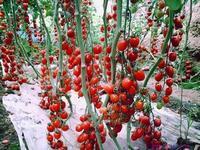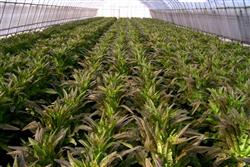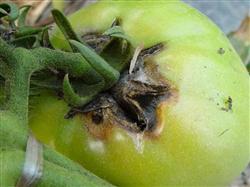Techniques of organic ecotype soilless cultivation of tomato

1. Facility conditions of organic ecological soilless cultivation Zoucheng mainly uses the existing energy-saving solar greenhouse for organic ecotype soilless cultivation of tomato. The organic ecological soilless cultivation system should be installed in the greenhouse, which mainly includes cultivation trough, cultivation substrate, irrigation facilities and so on. 1. Cultivation trough. In the greenhouse, 80 cm is left as the walkway in the north and 30 cm in the south, with bricks to form a north-south cultivation trough with an inner diameter of 48 cm, with a frame height of 24 cm (flat 1000-layer brick) and a slot spacing of 72 cm; or dig a trough 12 cm deep on the ground according to 48 cm wide, with 2 layers of bricks on the side to form a semi-underground cultivation trough. In order to prevent leakage and isolate the matrix from the soil, the base of the trough is covered with a 0.1 mm thick plastic film, and the edge of the film is pressed with the uppermost brick. The film is covered with 3 cm thick clean river sand, which is covered with a layer of textile bag, and the bag is filled with cultivation substrate. 2. Irrigation facilities. There should be tap water facilities or a reservoir with a water level difference of 1.5 meters, and an independent irrigation system should be built with a single shed. Except for metal pipes for pipes, plastic pipes can be used for the main pipes in the shed and the drip irrigation belt in the cultivation trough. The trough is covered with 1-2 drip irrigation belts, and a narrow plastic film 0.1 mm thick is placed on the drip irrigation belt to prevent drip irrigation water from spraying. 3. Cultivation substrate. The raw materials of organic matrix can be corn straw, mushroom residue, sawdust, etc. 15 days before use, the matrix is 20-25 cm thick, wet film is sprayed to disinfect and sterilize, and a certain amount of inorganic matter, such as sand and slag, is added. The mixed matrix of coal gangue, sawdust and corn straw in Beijing is 1:2:2. Add 2 kilograms of organic soilless cultivation special fertilizer and 10 kilograms of sterilized chicken manure to 1 cubic meter of substrate and then fill the trough. The substrate can be disinfected after each crop harvest, and the renewal life of the substrate is generally 3-5 years. Second, the implementation of soilless seedling Zoucheng used Caruso and Maofan 802 for organic soilless cultivation, and the two varieties showed good low temperature tolerance, weak light, high yield and strong disease resistance. Seed soaking was carried out on September 28 to accelerate germination, and most of the seeds could be sowed after they were exposed to white. In order to produce high-quality disease-free and insect-free seedlings, the artificial soilless hole plate method should be adopted. That is to say, the matrix is prepared according to peat ∶ vermiculite as 3 ∶ 1, and then 5kg of sterilized chicken manure and 0.5kg vermiculite compound fertilizer are added to the substrate. After mixing, a 72-hole suction plate is filled, one grain per hole, and the vermiculite is covered with 1cm, and the bottom of the plate is separated from the soil with plastic film. The temperature before emergence was 25-30 ℃, the temperature after emergence was 22-25 ℃ during the day and 10-15 ℃ at night, and the seedling plate remained moist. After about 30 days, the seedlings can be planted with 3-4 true leaves. 3. Before planting, the substrate was turned evenly and leveled, and the substrate in each cultivation trough was flooded with water to make the substrate fully absorb water. After water infiltration, the tomato was planted according to 2 rows of angles per trough, the substrate was slightly higher than that of Miaotuo, and the plant spacing was 30 cm. 3000 plants per mu. After planting, it was lightly watered to facilitate the close connection between the substrate and the root system of zucchini. 4. Cultivation and management techniques after planting. 1. Fertilizer and water management. In organic soilless cultivation of Lentinus edodes, watering should be carried out according to plant morphology, external climate and so on. Generally, watering water 5 days after planting to keep the rhizosphere matrix moist, do not make the plant too prosperous and grow, nor can it be controlled into a "small old seedling". Fruit setting rear service watering, generally sunny morning, afternoon each irrigated once, the time is 15-20 minutes; cloudy days can be irrigated less or not according to the specific conditions. Topdressing usually begins 20 days after planting, and then topdressing 10-15 grams per plant every 10 days, and 25 grams per plant 7 days after fruit. If the fertilizer is evenly sprinkled 5 cm away from the root, it can infiltrate into the substrate with drip irrigation water; it can also be mixed into the substrate and can not touch the root to avoid fertilizer damage to the plant. In view of the fact that carbon dioxide is deficient in the greenhouse, carbon dioxide topdressing can be carried out in the greenhouse to enhance the stress resistance and increase the yield of tomato. 2. Temperature and light management. After tomato planting, the temperature should be kept at 22-25 ℃ in daytime and 10-15 ℃ at night, and the temperature should be increased after fruit setting, 25-28 ℃ in daytime and 12 ℃ at night. The greenhouse temperature can reach 30 ℃ in a short time in deep winter, and the temperature can not be cooled down by strong wind to prevent the night temperature from being too low. After the severe winter, return to normal temperature management. Tomato has a strong preference for light. During the whole cultivation period, as long as the normal room temperature is ensured and the temperature in the greenhouse is not too low, the grass should be pulled early and released late to make the plant see more light as far as possible. 3. Hanging vines and pruning. When tomato leaves 6-7, each plant uses a polypropylene plastic rope to hang the vine, the upper part of the rope is fixed on the wire of the scaffolding, the lower part is tied to the base of the stem, and the stem vine and the hanging rope are intertwined to maintain upright growth. The late-maturing tomato varieties in Beijing were cultivated in winter with single-stem pruning, that is, only the growth and fruit of the main axis was retained, and all the lateral branches in the leaf axils were removed. In order to ensure the robust growth of the plant, branching should be carried out when the lateral branches are 10-15 cm long. 4. Flower and fruit protection and fruit thinning. In greenhouse cultivation of tomato, the humidity is high and the temperature is low, so it is not easy to fertilize. At 7-9 o'clock in the morning, 10-15 mg / kg 2.4 Mel D or 25-35 mg / kg tomato spirit can be dipped in flowers to increase the fruit setting rate. In order to ensure that the fruit is of large quality and uniform, 3-4 fruits per panicle should be retained, and the rest of the abnormal flowers and fruits should be removed in time so as not to consume nutrients. Fifth, after the harvest fruit enters the self-ripening period, it can be ready to be harvested and listed on the market. Those sold on the market after harvest can be picked when the fruit is well colored during the mature period; those listed the next day can be harvested in the middle of discoloration; if long-distance storage and transportation is needed, 1000 mg / kg ethephon should be used to accelerate ripening or not to harvest the fruit during the self-ripening period according to the storage and transportation time, and the stalk should be removed to prevent the fruit from being damaged during transportation.
- Prev

Efficient multiple cropping of lettuce, muskmelon and garlic in greenhouse
In the multiple cropping mode of lettuce, muskmelon and green garlic in the greenhouse, lettuce was sown and raised in mid-late September, transplanting in late October and harvested in mid-March; thick-skinned muskmelon was sown in late February, planted in late March, harvested at the end of June and early July; green garlic was sown in late July and harvested in mid-late October. The yield of lettuce is 4500 to 500 per mu.
- Next

Techniques for preventing physiological Diseases of Autumn Tomato
Early blight: after the onset of the disease, there are concentric wheel striated disease spots on the leaf surface, dark brown, watery. Before and after the attack, 70% mancozeb wettable powder 500 times diluent, or 75% chlorothalonil wettable powder 400 times diluent spray, once every 7 days, 3 times continuously for 4 times.
Related
- Where is it suitable to grow horseradish in China? it is expected to see the middle altitude horseradish in Alishan.
- How to prevent tomato virus disease reasonably? (Control methods included)
- Many people like to plant towel gourd on the balcony. What are the main points of this method and management?
- What crops can chili peppers be mixed with?
- Fertilization techniques and matters needing attention in Tomato
- What are the grafting techniques for peach seedlings in spring?
- Harm and control methods of root swelling disease of Chinese cabbage
- What are the pests of sweet potatoes? How to prevent and cure it?
- Symptoms, causes and Control methods of navel Rot in Tomato
- The cause of "Cucumber rotten bibcock" in Farmers' planting Cucumber and its Control Plan

